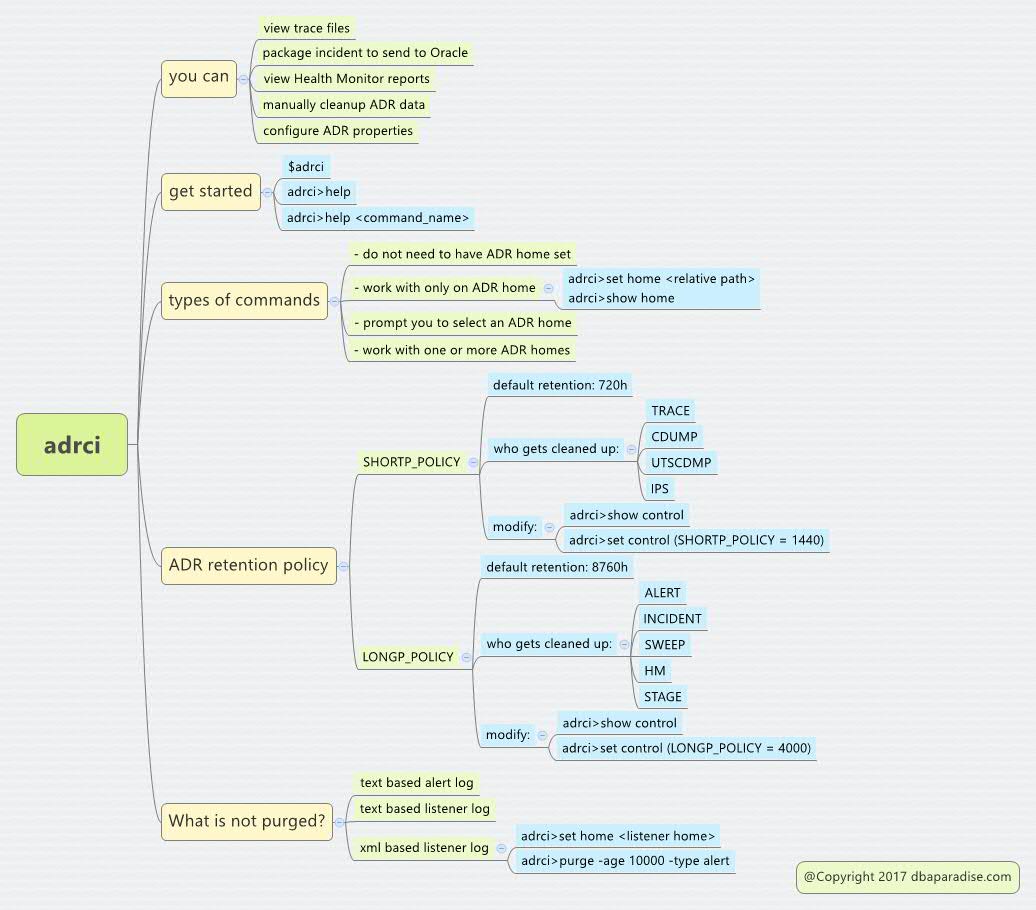
The Ultimate Guide For DBAs To adrci Tool
What? Another tool? Yes! And this one is your friend!
Do you know why? Because it makes your job easier!
How? That is what you’ll find out today!
Last week, I wrote a refresher on the ADR, or Automatic Diagnostic Repository. If you missed it, you can review it here: 5 Things That Every Good DBA Needs To Know About The ADR.
Starting with 11g, the new concept of ADR was introduced together with the adrci tool. DBAs around the world started reading about it, learning and studying about it. But as time passed by, most of the DBAs forgot about the adrci. They knew it existed, but vaguely remembered what it was supposed to do, and how it was supposed to work.
That is why this article will refresh those long forgotten memories of adrci, and will give you a new view on it!
1. What Is adrci?
2. How To Get Started With adrci?
3. What Type of Commands Are Available In adrci?
4. How Are Trace Files Cleaned Up?
5. How To Modify Retention Policy For ADR Data?
6. What Files Are Not Purged And How To Purge Them?
1. What Is adrci?
Adrci or ADR Command Interpreter, is a command line tool that enables you to interact with the Automatic Diagnostic Repository.
With adrci you can:
- view trace files
- package incident and problem data to send it to Oracle support
- view Health Monitor reports
- manually clean up the repository
- configure repository properties
To start the tool, type in adrci at the command line.
Did you know you do not need to provide credentials in order to use this tool?
The reason behind it is ADR data is not considered secure data, so no credentials are required.
2. How To Get Started With adrci?
If you have no idea on what commands are available to you, just type in help, and a list of commands will show up.
adrci> help
HELP [topic]
Available Topics:
CREATE REPORT
ECHO
EXIT
HELP
HOST
IPS
PURGE
RUN
SET BASE
SET BROWSER
SET CONTROL
SET ECHO
SET EDITOR
SET HOMES | HOME | HOMEPATH
SET TERMOUT
SHOW ALERT
SHOW BASE
SHOW CONTROL
SHOW HM_RUN
SHOW HOMES | HOME | HOMEPATH
SHOW INCDIR
SHOW INCIDENT
SHOW LOG
SHOW PROBLEM
SHOW REPORT
SHOW TRACEFILE
SPOOL
It is really cool that you can ask for help on a specific command, if you want a description of it:
adrci> help show tracefile
Usage: SHOW TRACEFILE [file1 file2 ...] [-rt | -t]
[-i inc1 inc2 ...] [-path path1 path2 ...]
Purpose: List the qualified trace filenames.
Options:
...
Examples:
1. Show all the trace files under the current home
"show tracefile"
2. Show all the mmon trace files in time reverse order
"show tracefile %mmon% -rt"
3. Show all trace files under incidents 123 456, and /home/someone/temp
"show tracefile -i 123 456 -path /home/someone/temp"
3. What Type of Commands Are Available In adrci?
Adrci commands can be grouped into 4 categories, based on whether or not they require to have the ADR home set or not.
- commands that do not need to have ADR home set: ECHO, HELP
- commands that work with only one ADR home, and return an error if there are multiple current homes: PURGE
If you try issuing the PURGE command without one home set you get the error: DIA-48448: This command does not support multiple ADR homes - commands that prompt you to select a specific ADR home: SHOW ALERT
- commands that work with one or more ADR homes: SHOW TRACEFILE
Now that you know how some of these commands work, you understand that you will need to set the homepath, or ADR home, depending on the actions you want to perform.
When you start adrci, the ADR homepath is set to null, which means that all the ADR homes that are under the same ADR base, are current.
To better understand this, lets see what homes we have available:
adrci> show homes ADR Homes: diag/rdbms/cdb1/cdb1 diag/tnslsnr/localhost/listener adrci> show base ADR base is "/u01/app/oracle"
Did you noticed that ADR home is relative to ADR base?
In order to set the ADR home to a specific home, just issue the command:
adrci> set home diag/rdbms/cdb1/cdb1
4. How Are Trace Files Cleaned Up?
This is my favorite part of adrci. When I think back to 9i and 10g days, a good DBA had to have some sort of script in place, outside the database, that would cleanup the trace files, in the bdump, udump and other locations.
Starting with 11g, when ADR was first introduced, the responsibility of cleaning up ADR data goes to: MMON background process.
Isn’t this awesome?
Let me step back a bit, MMON will not cleanup all of the files, but it will cleanup most of them. This is great, because if you do not setup any manual purging, the probability of running out of space in the ADR is reduced many folds!
Even if you are just starting in your DBA career, and are not aware of all the ins and outs, of all the things you need to create scripts for, you will not have problems with the ADR data, as MMON is here to the rescue!
In order for MMON to purge the files, some kind of retention policy needs to be defined. And it is. In ADR, there are two types of retention for the ADR data:
- SHORTP_POLICY – used for the data that has a short life. By default is set to 720 hours (equivalent of 30 days)
These are the components that follow the shortp_policy:
- TRACE
- CDUMP
- UTSCDMP
- IPS
- LONGP_POLICY – used for data that has a long life. By default is set to 8760 hours (equivalent of 365 days)
These are the components that follow the longp_policy:
- ALERT
- INCIDENT
- SWEEP
- STAGE
- HM
5. How To Modify Retention Policy For ADR Data?
Check current settings: show control
adrci> show control ADR Home = /u01/app/oracle/diag/rdbms/cdb1/cdb1: ************************************************************************* ADRID SHORTP_POLICY LONGP_POLICY LAST_MOD_TIME LAST_AUTOPRG_TIME LAST_MANUPRG_TIME ADRDIR_VERSION ADRSCHM_VERSION ADRSCHMV_SUMMARY ADRALERT_VERSION CREATE_TIME -------------------- -------------------- -------------------- ---------------------------------------- ---------------------------------------- ---------------------------------------- -------------------- -------------------- -------------------- -------------------- ---------------------------------------- 1467330218 720 8760 2014-01-07 16:09:18.320985 -08:00 2017-05-24 20:30:29.142386 -07:00 1 2 80 1 2014-01-07 16:09:18.320985 -08:00 1 rows fetched
Modify the policy:
adrci>set control (SHORTP_POLICY = 1440) adrci>set control (LONGP_POLICY = 4000)
6. What Files Are Not Purged And How To Purge Them?
Some files are not purged within the ADR. I list below some of them, there might be others too.
It is the responsability of the DBA to setup a purge mechanism, or file rotation for these files, just like in the olden days.
- text based alert log will not be purged automatically or manually.
However, the xml version of the alert log is rotated to log_XX.xml, when the log.xml reaches 10MB in size. The xml versions of the alert log are purged. - text based listener log file will not be purged automatically or manually.
- xml base listener log file will not be purged automatically. However you can manually purge it within adrci, or with an adrci script.
If you want to manually purge some of the ADR data, use the PURGE command:
adrci>purge -age 10000 -type alert
The age in the purge command is specified in minutes. This is something to keep in mind, as the retention policy for ADR is specified in hours instead.
To remember all of this, I am sharing with you a mind map!
If you enjoyed this article, and would like to learn more about databases, please sign up below, and you will receive
The Ultimate 3 Step Guide To Find The Root Cause Of The Slow Running SQL!
–Diana

I like the way you present the informations. Better than Oracle documents ‘-) very good job.
Thank you Macalga!
Nice post, thank you for sharing.
Thank you Foued!
Good information.
What about ADUMP files, I guess we can’t purge those files using adrci. Please let me know if we have any other options using adrci.
The document and the details provided are very clear and easy to understand.
Thank you Rijo
Thanks for the article. It’d very informative. Keep up the good work.
Thank you Vinay
Very useful information.